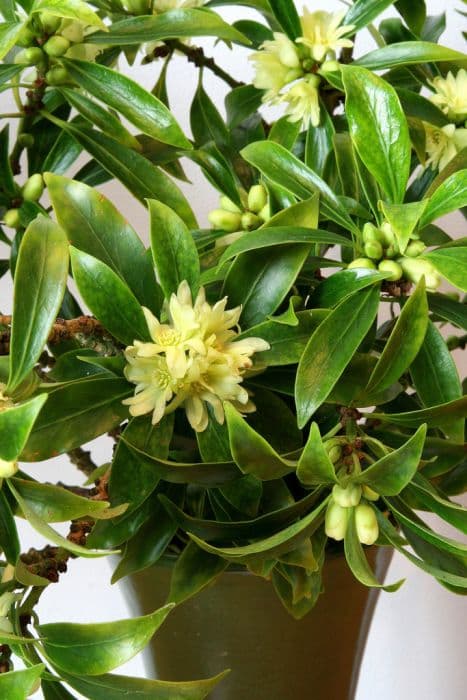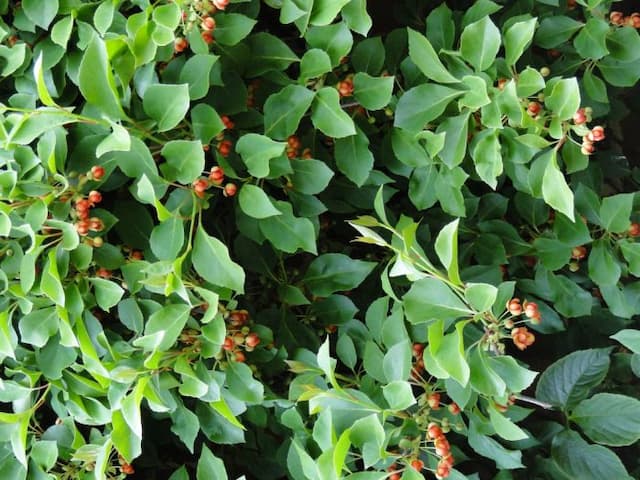Scarlet kadsura Kadsura coccinea

ABOUT
The plant in question, commonly referred to as simply Kadsura, boasts a striking appearance characterized by its climbing nature. It exhibits a twining growth habit, enabling it to ascend along supports and other vegetation, integrating itself seamlessly into its natural surroundings. The leaves are a vibrant green that stand out in their environment, lending the plant an air of lush vitality. They are glossy in texture, contributing an almost polished look to the foliage. The flowers of Kadsura add to its ornamental appeal, featuring a striking, often vibrant red color that contrasts against the green of the leaves. These blooms exude a delicate, sometimes spicy fragrance that can attract pollinators as well as the attention of human admirers. After the flowering period, the plant produces berries that provide an additional visual interest, changing from green to bright red as they mature. This transformation offers a dynamic aspect to the appearance of Kadsura throughout the growing season. Overall, the Kadsura plant presents a picturesque display, with its combination of climbing greenery, attractive flowers, and eye-catching berries. Its habit of growth and visual properties make it a notable presence in the areas where it thrives.
About this plant
 Names
NamesFamily
Schisandraceae.
Synonyms
Scarlet Kadsura, Red Kadsura, Magnolia Vine, Chinese Fever Vine.
Common names
Kadsura japonica var. coccinea, Schisandra coccinea, Uvaria coccinea.
 Toxicity
ToxicityTo humans
Kadsura coccinea, commonly known as the South China Kadsura, does not have a well-documented profile regarding toxicity to humans. As with many plants, unless there is a clear indication that it is safe to ingest, it is prudent to avoid consumption. If a plant is considered toxic, symptoms can range from mild gastrointestinal distress to more severe reactions such as organ damage or life-threatening conditions, depending upon the toxic compounds it contains. However, there is no specific information available suggesting that the South China Kadsura is harmful to humans, nor are there commonly reported symptoms of poisoning from this particular plant. It remains essential to exercise caution and seek expert guidance before ingesting any part of an unfamiliar plant.
To pets
For pets, the toxicity of Kadsura coccinea, or South China Kadsura, is not well documented. In the absence of specific information regarding its safety or toxicity, it is generally advisable to prevent pets from ingesting plants that are not known to be safe. A common approach to potential plant poisoning in pets includes monitoring for symptoms such as vomiting, diarrhea, drooling, lethargy, or more severe signs like tremors, seizures, or respiratory distress. If you suspect your pet has ingested any part of this plant, it is crucial to consult a veterinarian immediately. While the exact consequences of ingestion are not clearly defined for South China Kadsura, preventing exposure is the best precaution to maintain pet safety.
 Characteristics
CharacteristicsLife cycle
Perennials
Foliage type
Evergreen
Color of leaves
Green
Flower color
Red
Height
15 feet (4.57 meters)
Spread
6 feet (1.83 meters)
Plant type
Climber
Hardiness zones
9
Native area
Asia
Benefits
 General Benefits
General Benefits- Ornamental value: Kadsura coccinea, commonly known as the Red Kadsura, is valued for its attractive foliage and red fruit, making it a visually appealing addition to gardens.
- Habitat for Wildlife: The plant provides food in the form of its fruit for various birds and wildlife, supporting biodiversity.
- Cultural significance: In some cultures, the Red Kadsura may have traditional uses or be part of local heritage, contributing to cultural preservation.
- Landscape use: Due to its climbing nature, the Red Kadsura can be used to cover trellises, fences, or walls, providing a natural green aesthetic.
- Fragrance: The flowers of the Red Kadsura can emit a pleasant fragrance, enhancing the sensory experience of a garden or natural space.
- Shade provision: As a climbing plant, when grown over structures, the Red Kadsura can provide shade and create cooler microclimates in hot weather.
 Medical Properties
Medical Properties- Anti-inflammatory: Kadsura coccinea contains compounds that may help reduce inflammation in the body.
- Analgesic: It may have pain-relieving properties that can help alleviate discomfort.
- Antioxidant: The plant has been found to contain antioxidants that help in preventing oxidative stress.
- Antitumor: Some research suggests that it has antitumor effects against certain types of cancer cells.
- Immune system modulation: It might have properties that can modulate the immune system, potentially benefiting immune-related conditions.
- Antimicrobial: There is evidence to suggest that it possesses antimicrobial properties, which can help in fighting infections.
- Cardiovascular health: Compounds in Kadsura coccinea might contribute to the maintenance of cardiovascular health.
- Liver protection: It may have hepatoprotective properties that help in protecting the liver from damage.
- Antirheumatic: The plant has been used in traditional medicine for its potential antirheumatic benefits.
 Air-purifying Qualities
Air-purifying QualitiesThis plant is not specifically known for air purifying qualities.
 Other Uses
Other Uses- Kadsura coccinea, also known as Chinese sweet bean, can be used in ornamental landscaping due to its attractive glossy green leaves and the red fruit it bears.
- The vine-like growth pattern of Chinese sweet bean makes it suitable for creating living fences or privacy screens in gardens.
- The wood of the Chinese sweet bean plant can be used in carpentry for making small items like handles and decorative objects, as it is quite sturdy once mature.
- Chinese sweet bean's berries, with their bright color, are sometimes used in decorative arrangements or as natural dyes for fabrics or artworks.
- With proper training and support, Chinese sweet bean can be cultivated as a bonsai plant, offering a unique aesthetic for enthusiasts.
- The fragrant flowers of the Chinese sweet bean can be used in perfumery or as a natural air freshener when placed in a room.
- Dried parts of Chinese sweet bean can be used for educational purposes to study plant morphology and vine growth patterns.
- The seeds of Chinese sweet bean, lacking other known uses, may be considered for jewelry making, such as in beaded necklaces or bracelets.
- Chinese sweet bean can be incorporated into habitat gardens designed to attract and support wildlife such as birds, which feed on its fruit.
- Cultivation of Chinese sweet bean can serve as a conservation tool, as it aids in the preservation of this species which might be less common in the wild.
Interesting Facts
 Feng Shui
Feng ShuiThe Kadsura coccinea is not used in Feng Shui practice.
 Zodiac Sign Compitability
Zodiac Sign CompitabilityThe Kadsura coccinea is not used in astrology practice.
 Plant Symbolism
Plant Symbolism- Prosperity: Kadsura coccinea features bright red fruit, which in many cultures is associated with wealth and abundance.
- Longevity: As an evergreen plant, it represents eternal life and the wish for a long, healthy life.
- Protection: Some believe that the plant has protective qualities, shielding against negative energies.
- Festivity: The vibrant color of its fruit is often linked with celebration and joy, making it a symbol of festive occasions.
 Water
WaterThe Chinese magnolia vine prefers consistently moist soil, so it is important to water it when the top inch of soil starts to feel dry. For an indoor potted plant, this might equate to watering with approximately 16-24 ounces of water once every week, but this can vary depending on environmental conditions. To avoid waterlogging and potential root rot, ensure the pot has adequate drainage. During the active growing season in spring and summer, the plant might require more frequent watering, while in the cooler winter months, you can reduce the frequency. Always check the soil moisture level before watering to cater to the plant's needs.
 Light
LightThe Chinese magnolia vine thrives in bright, indirect sunlight. A spot near an east-facing or north-facing window where it can receive gentle morning sunlight or filtered light throughout the day would be ideal. Direct afternoon sunlight, especially in hotter climates, should be avoided as it may scorch the leaves. If the plant is outdoors, dappled shade works well to provide the light it needs without the intense direct sun.
 Temperature
TemperatureThe Chinese magnolia vine does well in temperatures ranging from 60 to 75 degrees Fahrenheit, which is typical for an indoor environment. It can tolerate minimum temperatures down to 50 degrees Fahrenheit but should not be subjected to freezing conditions, as it is not frost tolerant. The vine's ideal temperature range mirrors that of its native subtropical habitat, so it is best to avoid sudden temperature changes and drafts.
 Pruning
PruningPrune the Chinese magnolia vine to maintain its shape and encourage bushier growth. The best time for pruning is in late winter or early spring, just before new growth begins. Remove any dead or damaged stems and trim back overgrown branches to keep the plant looking tidy. Depending on growth, light pruning can be done once or twice a year as needed.
 Cleaning
CleaningAs needed
 Soil
SoilThe Chinese Bittersweet prefers a well-draining, humus-rich soil mix with a pH between 5.5 and 6.5; an ideal mix would be 2 parts peat, 1 part perlite, and 1 part pine bark.
 Repotting
RepottingChinese Bittersweet should be repotted every 2 to 3 years in spring to refresh the soil and accommodate growth.
 Humidity & Misting
Humidity & MistingChinese Bittersweet thrives in moderate to high humidity levels, preferably between 60% and 80%.
 Suitable locations
Suitable locationsIndoor
Place in bright, indirect light and maintain high humidity.
Outdoor
Partial shade, shelter from strong winds, and mulch to retain moisture.
Hardiness zone
8-10 USDA
 Life cycle
Life cycleKadsura coccinea, also known as Scarlet Kadsura, begins its life cycle as a seed, which after dispersal, germinates in a suitable habitat, typically in shaded forest conditions. The seedling then establishes roots and shoots, and as it transitions to the juvenile stage, it develops leaves and slowly starts to climb or sprawl, as it is a vine. As it matures, the Kadsura coccinea develops into a full-grown vine with a woody stem, exhibiting vigorous vegetative growth through the production of more stems and leaves. Upon reaching maturity, it produces separate male and female flowers on different plants (dioecious), with pollination occurring often through the assistance of insects or wind. Once pollinated, the female flowers develop into spherical, red fruits that are dispersed by animals, completing the life cycle when these fruits release seeds into the environment. The plant will continue to grow and may flower and fruit annually, depending on environmental conditions.
 Propogation
PropogationPropogation time
Spring-Early summer
Kadsura coccinea, commonly known as the magnolia vine, can be propagated from seed or by cuttings, with the latter being the most popular and reliable method. To propagate the magnolia vine by cuttings, select a healthy, semi-ripe stem during the active growing season, typically in late spring to early summer. The cutting should be about 4 to 6 inches (approximately 10 to 15 centimeters) long, with a few leaves left at the top. Remove the lower leaves, dip the cut end in a rooting hormone to stimulate root development, and plant it in a well-draining potting mix. Maintain a humid environment around the cutting by covering the pot with a plastic bag or placing it in a propagator, and keep it in a warm but indirect light setting until roots have established, which can take several weeks. Once rooted, the cutting can be gradually acclimatized to normal conditions before final transplantation.


